
Global electronics components and solutions distributor Arrow Electronics (NYSE: ARW) beat Wall Street’s revenue expectations in Q2 CY2025, with sales up 10% year on year to $7.58 billion. On top of that, next quarter’s revenue guidance ($7.6 billion at the midpoint) was surprisingly good and 4.2% above what analysts were expecting. Its non-GAAP profit of $2.43 per share was 18.7% above analysts’ consensus estimates.
Is now the time to buy Arrow Electronics? Find out by accessing our full research report, it’s free.
Arrow Electronics (ARW) Q2 CY2025 Highlights:
- Revenue: $7.58 billion vs analyst estimates of $7.16 billion (10% year-on-year growth, 5.9% beat)
- Adjusted EPS: $2.43 vs analyst estimates of $2.05 (18.7% beat)
- Adjusted EBITDA: $225.7 million vs analyst estimates of $235.2 million (3% margin, 4% miss)
- Revenue Guidance for Q3 CY2025 is $7.6 billion at the midpoint, above analyst estimates of $7.3 billion
- Adjusted EPS guidance for Q3 CY2025 is $2.26 at the midpoint, below analyst estimates of $2.57
- Operating Margin: 2.5%, in line with the same quarter last year
- Free Cash Flow was -$224.5 million, down from $298.1 million in the same quarter last year
- Market Capitalization: $6.73 billion
Company Overview
Founded as a single retail store, Arrow Electronics (NYSE: ARW) provides electronic components and enterprise computing solutions to businesses globally.
Revenue Growth
Reviewing a company’s long-term sales performance reveals insights into its quality. Any business can have short-term success, but a top-tier one grows for years. Unfortunately, Arrow Electronics struggled to consistently increase demand as its $28.5 billion of sales for the trailing 12 months was close to its revenue five years ago. This was below our standards and suggests it’s a low quality business.
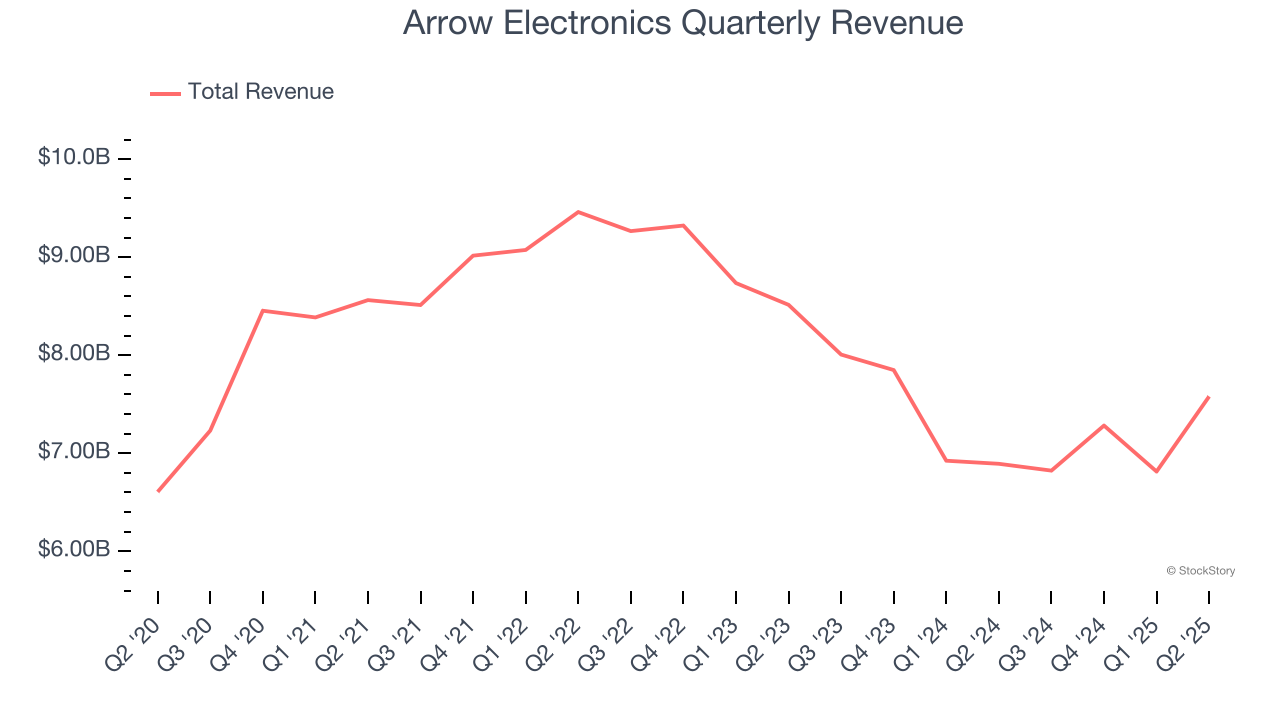
Long-term growth is the most important, but within industrials, a half-decade historical view may miss new industry trends or demand cycles. Arrow Electronics’s recent performance shows its demand remained suppressed as its revenue has declined by 10.8% annually over the last two years. 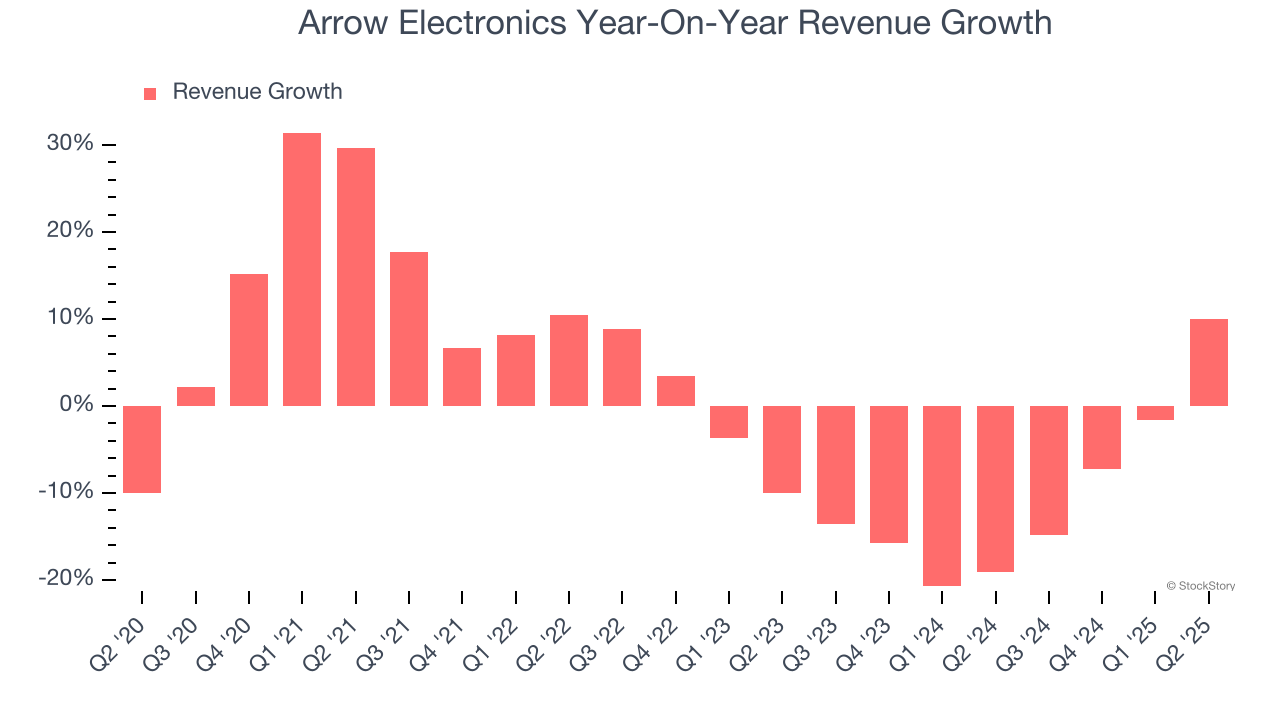
Arrow Electronics also breaks out the revenue for its most important segments, Components and ECS, which are 69.7% and 30.3% of revenue. Over the last two years, Arrow Electronics’s Components revenue (electronic component sales) averaged 14.9% year-on-year declines. On the other hand, its ECS revenue (computing solutions and services) averaged 3.9% growth.
This quarter, Arrow Electronics reported year-on-year revenue growth of 10%, and its $7.58 billion of revenue exceeded Wall Street’s estimates by 5.9%. Company management is currently guiding for a 11.4% year-on-year increase in sales next quarter.
Looking further ahead, sell-side analysts expect revenue to grow 6.3% over the next 12 months. Although this projection implies its newer products and services will fuel better top-line performance, it is still below the sector average.
Today’s young investors won’t have read the timeless lessons in Gorilla Game: Picking Winners In High Technology because it was written more than 20 years ago when Microsoft and Apple were first establishing their supremacy. But if we apply the same principles, then enterprise software stocks leveraging their own generative AI capabilities may well be the Gorillas of the future. So, in that spirit, we are excited to present our Special Free Report on a profitable, fast-growing enterprise software stock that is already riding the automation wave and looking to catch the generative AI next.
Operating Margin
Operating margin is a key measure of profitability. Think of it as net income - the bottom line - excluding the impact of taxes and interest on debt, which are less connected to business fundamentals.
Arrow Electronics was profitable over the last five years but held back by its large cost base. Its average operating margin of 4.2% was weak for an industrials business. This result isn’t too surprising given its low gross margin as a starting point.
Looking at the trend in its profitability, Arrow Electronics’s operating margin decreased by 1.2 percentage points over the last five years. Arrow Electronics’s performance was poor no matter how you look at it - it shows that costs were rising and it couldn’t pass them onto its customers.
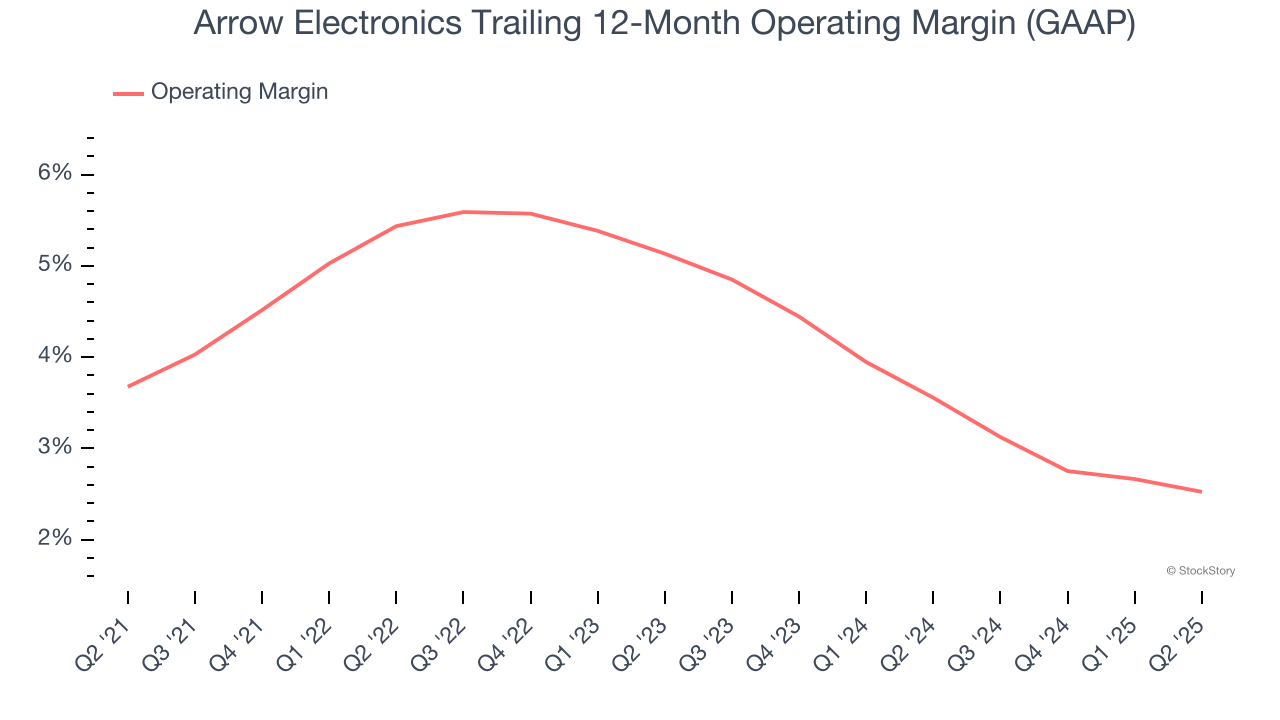
This quarter, Arrow Electronics generated an operating margin profit margin of 2.5%, in line with the same quarter last year. This indicates the company’s cost structure has recently been stable.
Earnings Per Share
Revenue trends explain a company’s historical growth, but the long-term change in earnings per share (EPS) points to the profitability of that growth – for example, a company could inflate its sales through excessive spending on advertising and promotions.
Arrow Electronics’s EPS grew at an unimpressive 7.7% compounded annual growth rate over the last five years. This performance was better than its flat revenue but doesn’t tell us much about its business quality because its operating margin didn’t improve.
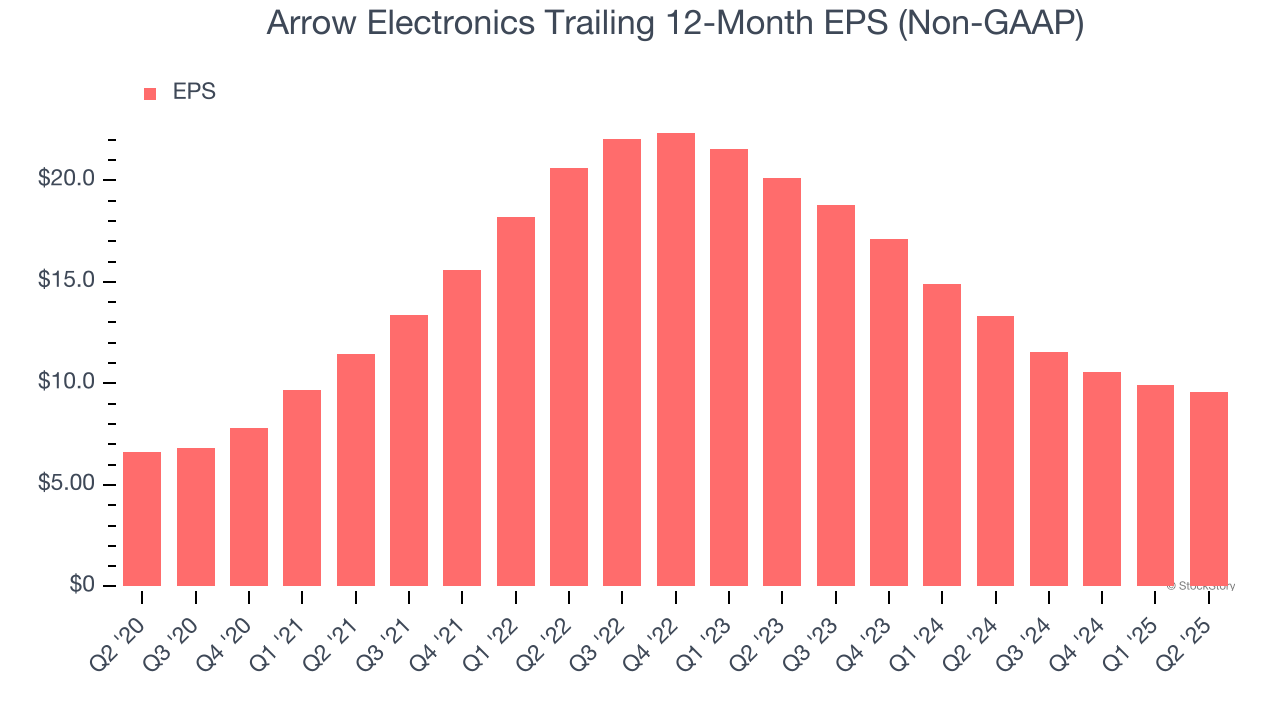
We can take a deeper look into Arrow Electronics’s earnings to better understand the drivers of its performance. A five-year view shows that Arrow Electronics has repurchased its stock, shrinking its share count by 33.9%. This tells us its EPS outperformed its revenue not because of increased operational efficiency but financial engineering, as buybacks boost per share earnings. 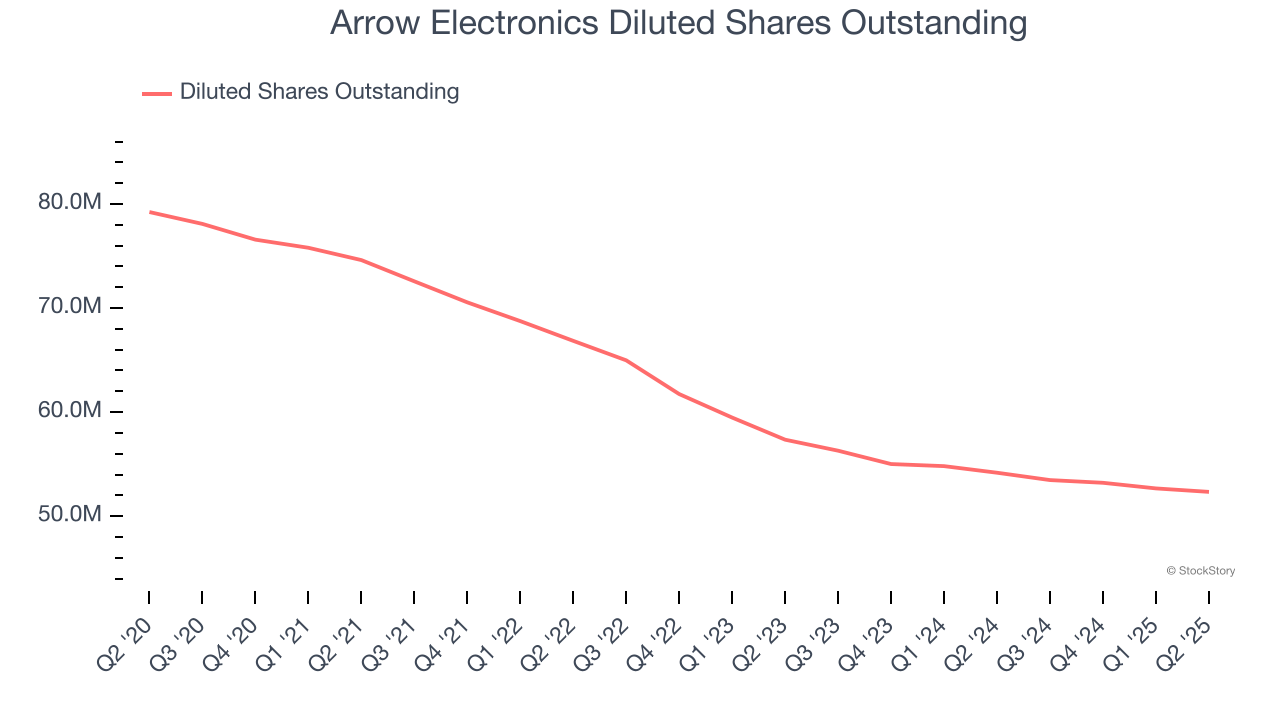
Like with revenue, we analyze EPS over a shorter period to see if we are missing a change in the business.
For Arrow Electronics, its two-year annual EPS declines of 31% show it’s continued to underperform. These results were bad no matter how you slice the data.
In Q2, Arrow Electronics reported adjusted EPS at $2.43, down from $2.78 in the same quarter last year. Despite falling year on year, this print easily cleared analysts’ estimates. Over the next 12 months, Wall Street expects Arrow Electronics’s full-year EPS of $9.58 to grow 34.3%.
Key Takeaways from Arrow Electronics’s Q2 Results
We were impressed by how significantly Arrow Electronics blew past analysts’ revenue expectations this quarter. We were also glad its ECS revenue topped Wall Street’s estimates. On the other hand, its EPS guidance for next quarter missed and its EBITDA fell short of Wall Street’s estimates. Overall, this print was mixed but still had some key positives. The market seemed to be hoping for more, and the stock traded down 5.9% to $122.26 immediately following the results.
Should you buy the stock or not? We think that the latest quarter is only one piece of the longer-term business quality puzzle. Quality, when combined with valuation, can help determine if the stock is a buy. We cover that in our actionable full research report which you can read here, it’s free.




